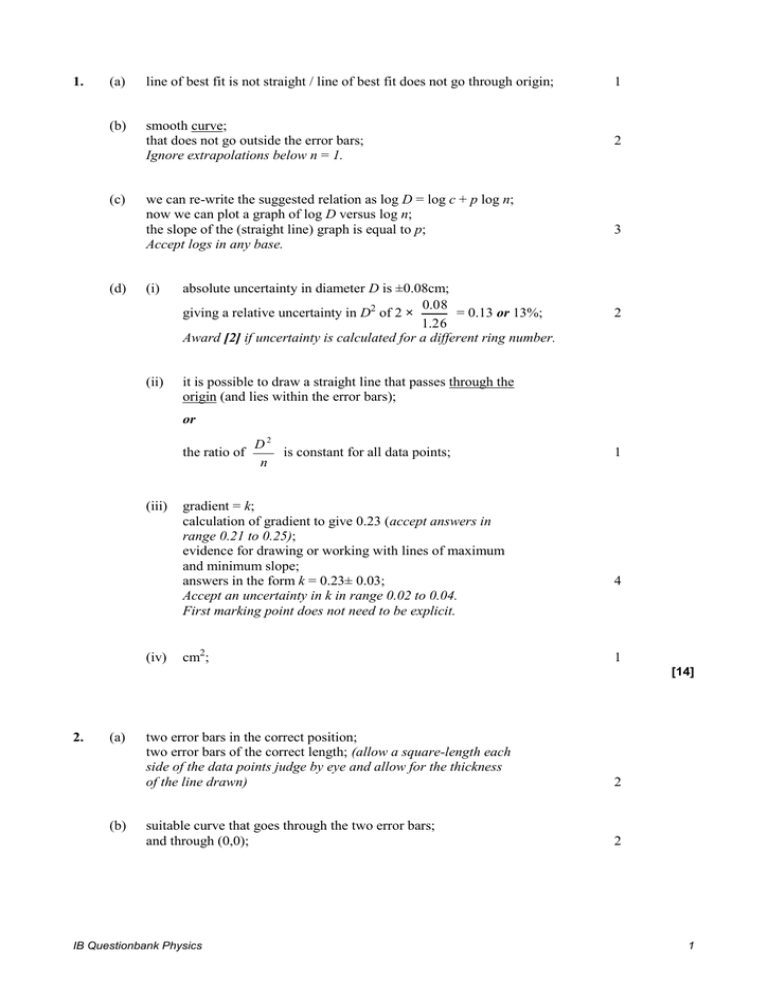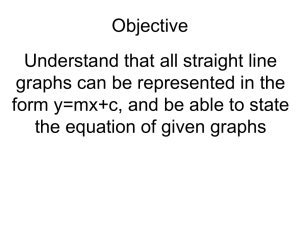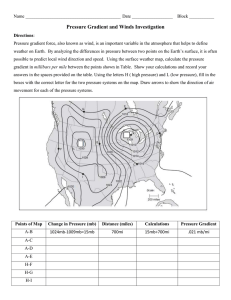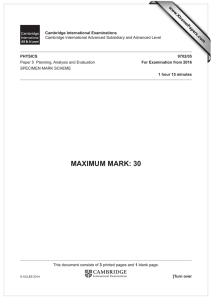1. (a) line of best fit is not straight / line of best fit does not go through
advertisement

1. (a) line of best fit is not straight / line of best fit does not go through origin; 1 (b) smooth curve; that does not go outside the error bars; Ignore extrapolations below n = 1. 2 (c) (d) we can re-write the suggested relation as log D = log c + p log n; now we can plot a graph of log D versus log n; the slope of the (straight line) graph is equal to p; Accept logs in any base. (i) (ii) absolute uncertainty in diameter D is ±0.08cm; 0.08 giving a relative uncertainty in D2 of 2 × = 0.13 or 13%; 1.26 Award [2] if uncertainty is calculated for a different ring number. 3 2 it is possible to draw a straight line that passes through the origin (and lies within the error bars); or the ratio of (iii) (iv) D2 is constant for all data points; n gradient = k; calculation of gradient to give 0.23 (accept answers in range 0.21 to 0.25); evidence for drawing or working with lines of maximum and minimum slope; answers in the form k = 0.23± 0.03; Accept an uncertainty in k in range 0.02 to 0.04. First marking point does not need to be explicit. cm2; 1 4 1 [14] 2. (a) (b) two error bars in the correct position; two error bars of the correct length; (allow a square-length each side of the data points judge by eye and allow for the thickness of the line drawn) 2 suitable curve that goes through the two error bars; and through (0,0); 2 IB Questionbank Physics 1 (c) (d) a straight line cannot be drawn through the error bars and through the origin; so height is not directly proportional to the diameter; (and) height is proportional to energy; 3 the gradient of the line gives the value of the power coefficient/exponent/ 1 1 lg d = lg h + constant and lg d = lg h + constant; 3 4 gradient of data line = 0.33 (±0.02) ; gradient of max and gradient of min = 0.37 (±0.02) and 0.29(±0.02); some conclusion as to why this supports theory 1 e.g. therefore the uncertainties do not allow for n = 0.25 so data supports theory 1; 4 [11] 3. (a) line going through each error bar; 1 (b) (i) line does not go through (0,0)/origin so no; Watch for ECF from (a). 1 (ii) line is curved / gradient not constant so no; 1 (c) (d) line drawn to find intercept on y-axis; 4.2(±0.1)m; 2 large (at least half of line) triangle from straight line portion of graph; slope = 0.012(±0.001)(m s–1); volume per second=area × slope; (0.022 m3 s–1) 3 Alternatively for [2 max]. determines height difference over time range within 0 and 120 s; 1.8 [differencein heights] volume per second = ; time between heights (0.022 m3 s–1) (e) (850 × 0.022) = 19 m3 or (850 × 0.02) = 17 m3; IB Questionbank Physics 1 2 (f) graph starts at same point but half initial gradient by eye; 1 way down y-axis; 4 Original line need not be shown. Allow ECF from (c) if the curve begins at (0, 3.5). line always lower than original by eye and ending about 2 [11] 4. B [1] 5. D [1] 6. D [1] 7. B [1] IB Questionbank Physics 3 8. B [1] 9. B [1] IB Questionbank Physics 4





